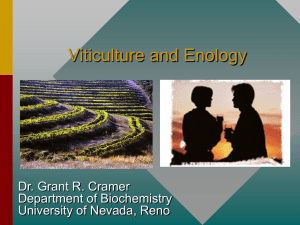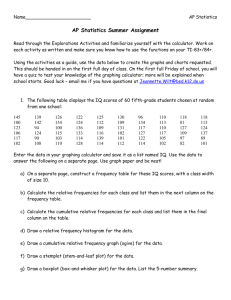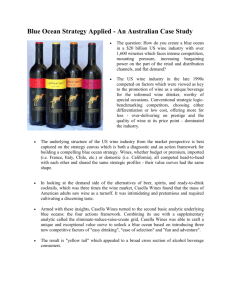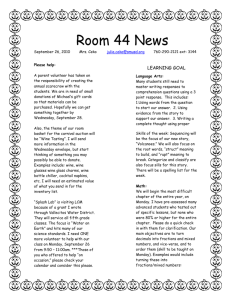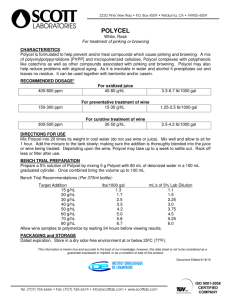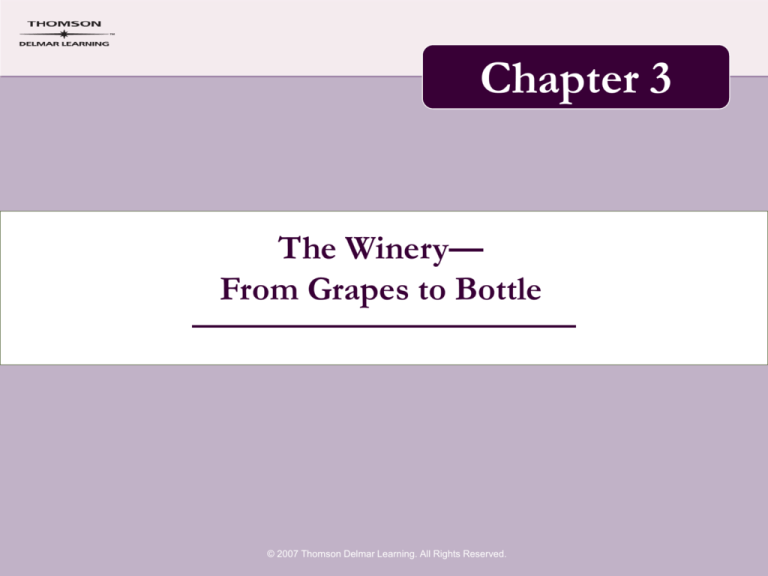
Chapter 3
The Winery—
From Grapes to Bottle
© 2007 Thomson Delmar Learning. All Rights Reserved.
Objectives
• After reading this chapter, you should be able
to
– display an understanding of how both red and
white table wines are produced.
– describe how sparkling wine is produced.
– explain how dessert wines are produced.
© 2007 Thomson Delmar Learning. All Rights Reserved.
Introduction
• Great wines begin in the vineyard, but they are
finished at the winery.
• Like a chef, the winemaker works with flavors and
aromas to create a wine that consumers will enjoy.
• The decisions the winemaker makes may appear
random in nature, but in reality they are based on a
scientific understanding of the techniques used to
produce wine.
© 2007 Thomson Delmar Learning. All Rights Reserved.
Introduction (continued)
• Complicating the winemaker’s quest to create
great wine is the fact that people have
different tastes and preferences, and there is
no one “ideal” style wine.
• During the 6,000-year history of winemaking, its production has evolved into a
number of complex procedures that produce
a variety of wines.
© 2007 Thomson Delmar Learning. All Rights Reserved.
Introduction (continued)
• Table wine is a wine designed to accompany food.
It is produced in numerous forms, both red and
white.
– It is the most common type of wine consumed in the
United States, making up over 90 percent of the market.
– A table wine is a still wine (a wine without
effervescence).
– A table wine is also relatively dry (without sweetness).
– It has a moderate alcohol content of about 11 to 15
percent.
© 2007 Thomson Delmar Learning. All Rights Reserved.
Introduction (continued)
• In the United States, a wine must be less than 14
percent alcohol to be labeled a “table wine.”
– This number was chosen for reasons of tax collection,
not the true definition of being a wine made to
complement food.
• Grapes are usually picked at 22 to 25 degrees Brix
(°B) to obtain this alcohol level.
– Brix is equal to the percentage of sugar by weight.
© 2007 Thomson Delmar Learning. All Rights Reserved.
The Process of Fermentation
• Fermentation is the process of yeast,
unicellular (one-celled) fungi, converting the
sugar in grape juice to alcohol and carbon
dioxide.
• Other microorganisms can do this, but yeast
ferment with the most efficiency and can
survive in the higher alcohol at the end of
fermentation.
© 2007 Thomson Delmar Learning. All Rights Reserved.
The Process of Fermentation
• The species of yeast that is best suited for
winemaking is called Saccharomyces
cerevisiae.
– The name Saccharomyces is derived from the Latin
sugar-fungus; cerevisiae refers to grain.
– Saccharomyces cerevisiae’s most common use is in
bread making.
© 2007 Thomson Delmar Learning. All Rights Reserved.
The Process of Fermentation
• The rate of fermentation is affected by a
number of factors, including
– temperature—the warmer the juice is, the faster it
will ferment.
• However, above 100°F, yeast will die off.
– acidity—the higher the concentration of acid (the
lower the pH), the slower the rate of
fermentation.
© 2007 Thomson Delmar Learning. All Rights Reserved.
The Process of Fermentation (continued)
– nutrients—if the juice is low in nutrients, the
yeast may not be able to ferment to dryness.
– alcohol—at higher concentrations, 13 percent to
16 percent depending on strain, yeast begin to
die.
– sugar—although sugar is required for yeast
growth, if the sugar concentration is greater than
30 percent, it inhibits yeast growth.
© 2007 Thomson Delmar Learning. All Rights Reserved.
Natural Fermentation
• Wine was made for thousands of years before
there was knowledge of such things as
microscopic organisms called yeast.
• Although early winemakers did not understand
the mechanism, they knew how to use it to
produce wine.
• Some wineries use natural or “wild” yeast that
live on the grape skins to make wine.
© 2007 Thomson Delmar Learning. All Rights Reserved.
Natural Fermentation (continued)
• “Wild” yeast can give the wine more
complexity, but there also is a higher risk of
off-flavors or incomplete fermentation.
• Today most winemakers use commercially
available strains of yeast.
– These yeasts are similar appearance to baker’s
yeast, and they give the winemaker a clean,
efficient fermentation.
© 2007 Thomson Delmar Learning. All Rights Reserved.
Harvest
• Grapes must be harvested and processed as soon as
they reach their peak of flavor.
• The weather conditions set the pace of harvest.
• Once the grower and the winemaker have
determined that the grapes have reached their
optimum ripeness and flavor, they are picked and
brought to the winery.
• At the winery the crop is weighed, inspected, and
analyzed before being processed.
© 2007 Thomson Delmar Learning. All Rights Reserved.
Red Wine Crush and Fermentation
• After the grapes are weighed and inspected,
they are brought to the receiving hopper and
unloaded.
• At the bottom of the hopper, there is either a
screw or a belt conveyor that is used to
transport the fruit to the stemmer-crusher.
© 2007 Thomson Delmar Learning. All Rights Reserved.
Red Wine Crush and Fermentation
(continued)
• The stemmer-crusher has two functions: first
it takes the berries off the stems, and second
it breaks the berries open to release the juice.
– The stemmer portion separates the berries from
the stems.
– The crusher breaks open the berries and releases
the juice.
© 2007 Thomson Delmar Learning. All Rights Reserved.
Red Wine Crush and Fermentation
(continued)
• The mixture of approximately 80 percent
juice, 16 percent skins, and 4 percent seeds
produced by the crusher is called must.
• At this point, the must is liquid enough to be
pumped to a tank for fermentation.
– In modern wineries, fermentation tanks are
usually made of stainless steel, although vats
made of wood or concrete are also still in use.
© 2007 Thomson Delmar Learning. All Rights Reserved.
Red Wine Crush and Fermentation
(continued)
• After the tank is loaded, the must is analyzed
and adjusted if necessary.
• The compounds that are added to adjust the
must are natural and already present in the
must to some degree, such as sugar, acid,
nutrients, and yeast.
– The exception to this is the preservative sulfur
dioxide.
© 2007 Thomson Delmar Learning. All Rights Reserved.
Red Wine Crush and Fermentation
(continued)
• Additives to wine are regulated and vary from
region to region.
– For example, it is legal to add sugar to must in
France but not acid, whereas in California the
opposite is true.
© 2007 Thomson Delmar Learning. All Rights Reserved.
Red Wine Crush and Fermentation
(continued)
• Once the fermentation begins, the carbon
dioxide that is evolved causes the skins to
float to the top of the tank and form a cap.
– The juice from most red wine varieties is clear, so
it is necessary to extract the red color out of the
skins to make red wine.
– If the skins are in a cap that is floating above the
juice, very little extraction will take place.
© 2007 Thomson Delmar Learning. All Rights Reserved.
Methods of Cap Management
• To combat extraction problems, the cap is
mixed into the juice several times a day.
– The manner in which it is mixed, and the
frequency, have a major effect on the overall style
of the wine being made.
• Punching down is the oldest, simplest
method of mixing the cap of skins and the
juice. A punch-down device is used to press
down the cap into the juice.
© 2007 Thomson Delmar Learning. All Rights Reserved.
Methods of Cap Management (continued)
• Pumping over is where juice is irrigated over
the top of the cap.
– As the juice percolates through the skins, it
extracts the color and flavor.
• Rotary fermentors are the most modern and
least labor-intensive method.
– They are large horizontal tanks that are rotated
and so the cap is rolled over into the juice.
© 2007 Thomson Delmar Learning. All Rights Reserved.
Methods of Cap Management (continued)
• Carbonic maceration is where a portion or
all of the grapes are not crushed but loaded
into the tank as whole clusters.
• As the fermentation in the juice progresses, it
also begins to take place within the cells of
the intact grape berries.
– This produces soft tannins and a unique
strawberry or bubble gum aroma.
© 2007 Thomson Delmar Learning. All Rights Reserved.
Methods of Cap Management (continued)
• Extended maceration is more suited to bigbodied red wines such as Cabernet
Sauvignon.
• In this technique, at the end of fermentation
the must is not pressed, and the skins are left
in contact with the young wine from 1 to 8
weeks.
– This method is used to give big-bodied wines less
tannins.
© 2007 Thomson Delmar Learning. All Rights Reserved.
Red Fermentation
• Red wines ferment at 75° to 90°F; at this
temperature, there is optimal extraction of
color without harming the yeast.
– Fermentation usually takes from 1 to 3 weeks at
this temperature.
© 2007 Thomson Delmar Learning. All Rights Reserved.
Pressing the Skins
• In red wines, when fermentation is complete
and the winemaker is satisfied with the flavor
extraction, it is time to separate the wine
from the skins.
• The majority of the wine is simply drained
out of the tank by gravity; however, 10 to 20
percent is held within the skins still inside the
tank.
© 2007 Thomson Delmar Learning. All Rights Reserved.
Pressing the Skins (continued)
• The skins are then removed from the tank
and loaded into a press, which squeezes out
their remaining liquid.
• There are a number of types of presses, but
they all work in the same manner.
– Force is applied to a layer of skins against a
screened or slatted surface that allows the juice
through but holds the skins and seeds back.
© 2007 Thomson Delmar Learning. All Rights Reserved.
Types of Presses
• The basket press is the oldest and most
simple design.
– It is a vertical cylinder made of slats of wood
arranged with small gaps in between them.
– Traditional basket presses are gentle but require
the cake to be broken up by hand in between
press cycles.
© 2007 Thomson Delmar Learning. All Rights Reserved.
Types of Presses (continued)
• Tank presses are cylindrical steel tanks that
are 3 to 8 feet in diameter and are mounted
horizontally.
– On one side of the interior, there is an inflatable
bag or membrane, and on the other side is a
series of perforated screens or channels.
– The bag inflates squeezing the skins against the
screens to remove the juice.
© 2007 Thomson Delmar Learning. All Rights Reserved.
Press Fractions
• Free run is the first wine to come off during
pressing and it is the highest-quality juice.
• Press fraction—As the cycles of pressing go on,
the quality of the juice diminishes becoming more
astringent and bitter.
– The young wine is then collected in a sump at the base of
the press before being pumped into a receiving tank.
• After the skins dry, they are called pomace.
© 2007 Thomson Delmar Learning. All Rights Reserved.
Settling and Racking
• Yield after fermentation is typically about 170
gallons of wine per ton of grapes.
• After pressing, the wine is pumped to a tank
in the winery cellar for storage.
– At this point the new wine is very turbid and full
of suspended solids such as yeast cells, particles
of grape skins, and pulp.
© 2007 Thomson Delmar Learning. All Rights Reserved.
Settling and Racking (continued)
• After several days, the suspended solids begin
to settle out to the bottom of the tank
forming a layer of thick mud-like material
called lees.
• After a week or two the clean wine is
decanted off the layer of lees in a process
called racking.
© 2007 Thomson Delmar Learning. All Rights Reserved.
White Wine Crush and Fermentation
• White wines are made from white (green
skinned) grape varieties.
– Because the juice of most red grapes is colorless,
it is also possible to make a white wine from red
grapes as is done with White Zinfandel and Blanc
de Noir sparkling wine.
• Red wines receive most of their flavor from
the skins, and whites get theirs from the juice.
© 2007 Thomson Delmar Learning. All Rights Reserved.
White Wine Crush and Fermentation
(continued)
• The most important difference in processing
is that red wines are pressed after
fermentation and white wines are pressed
before.
– White are usually picked early in the morning and
brought to the winery while they are still cool to
preserve the fresh fruit flavors.
© 2007 Thomson Delmar Learning. All Rights Reserved.
White Wine Crush and Fermentation
(continued)
• In white winemaking, the grapes are picked,
weighed, inspected, and unloaded into the
receiving hopper much in the same way they
are for red wine production.
• After they are picked, red and white
winemaking techniques diverge and the juice
must be separated from the grapes.
© 2007 Thomson Delmar Learning. All Rights Reserved.
White Wine Crush and Fermentation
(continued)
• The fruit can be
– crushed and pressed.
• This is similar to the way red grapes are handled
except the pressing takes place prior to fermentation.
– crushed, dejuiced, and pressed.
• Here the juice is drained out by gravity between
crushing and pressing.
– whole cluster pressed.
• Uncrushed clusters are pressed directly—the most
gentle method.
© 2007 Thomson Delmar Learning. All Rights Reserved.
White Wine Fermentation
• After pressing, the juice is pumped to a settling tank.
• The juice is kept cool, at around 50°F, and held in
the settling tank for 12 to 72 hours to allow the lees
to form.
• The juice is racked off the grape solids, or primary
lees, to avoid the production of undesirable flavors
during fermentation.
– In the fermentation tank, yeast and fermentation
additives are added.
© 2007 Thomson Delmar Learning. All Rights Reserved.
White Wine Fermentation (continued)
• White wine fermentations take place at a cool
temperature, 45° to 60°F, to help retain its
fruity aromas.
– White fermentations take two to three times as
long as red fermentations, about 3 to 6 weeks.
– After fermentation, the new wine is racked off
the yeast lees.
© 2007 Thomson Delmar Learning. All Rights Reserved.
Barrel Fermentation
• Barrel fermentation of white wine gives it a
distinctly toasty aroma and is very popular
with Chardonnay.
• After the fermentation is finished, the barrels
are topped off and the wine is left in contact
with the yeast lees at the bottom of the
barrel.
– This technique of aging is called sur lie (French
for “on the lees”).
© 2007 Thomson Delmar Learning. All Rights Reserved.
Barrel Fermentation (continued)
• Sur lie aging:
– This gives the wine more of a yeasty-bready
aroma and more viscosity.
– The young wine can be left sur lies for many
months; sometimes the yeast is periodically
stirred to intensify the character.
© 2007 Thomson Delmar Learning. All Rights Reserved.
Malolactic Fermentation
• The most prevalent acids in wine are tartaric acid
and malic acid.
• Malolactic bacteria convert malic acid in wine into
lactic acid.
• Malolactic fermentation has several effects on the
wine,
– De-acidification, malic acid is a stronger acid than lactic
– Microbial stability, if malo-lactic finishes during aging it
will not spoil the wine by taking place in the bottle.
– Malolactic fermentation produces a compound called
diacetyl that has a distinct buttery character.
© 2007 Thomson Delmar Learning. All Rights Reserved.
Malolactic Fermentation (continued)
• Malolactic fermentation usually takes place after the
primary, or alcoholic, fermentation and occurs at a
much slower pace.
• Malolactic fermentation is usually encouraged in red
wines for reasons of stability.
• With white wines, it is a stylistic concern.
– In a light-bodied fruity wine like Riesling, it is usually
avoided, while in a rich oak-aged Chardonnay it would be
more appropriate.
© 2007 Thomson Delmar Learning. All Rights Reserved.
Barrels and Aging
• The first to store wine in barrels were the Romans.
– Winemakers soon discovered that storing wine in barrels
had positive effects on the wine’s flavor.
– Barrel makers are called coopers.
• There are two types of reactions that are taking
place during aging:
– The wine undergoes a slow oxidation.
– Flavor components are absorbed from the wood.
© 2007 Thomson Delmar Learning. All Rights Reserved.
Barrels and Aging (continued)
• Oak is the chosen wood for wine barrel
production.
– It is strong and durable; it is also nonporous, so
the barrels will not leak.
– It also has excellent flavor and aroma compounds
that are extracted into the wine.
© 2007 Thomson Delmar Learning. All Rights Reserved.
Barrels and Aging (continued)
• The two major categories of oak are
European and American.
• There are two species of European oak that
are used for making wine barrels, Ouercus
sessilis and Quercus robar; they are grown
throughout France and central Europe.
– European oak is known for giving wine a rich,
toasty vanilla aroma.
© 2007 Thomson Delmar Learning. All Rights Reserved.
Barrels and Aging (continued)
• In America Quercus alba, or white oak, is used
for barrel making and has stronger, more
woody flavors than European oak.
• Beyond the type of oak used, a barrel’s flavor
varies depending on the forest the wood is
from and the various methods of production
that different coopers use.
© 2007 Thomson Delmar Learning. All Rights Reserved.
Barrels and Aging (continued)
• Much of the flavor obtained from aging wine in
barrels comes from what is extracted out of the oak;
however, the softening of the wine’s texture that
comes with aging is due to the process of slow
oxidation.
– Oak has the quality of being semipermeable to oxygen
allowing a small amount of oxygen to be incorporated in
an aging wine.
– This helps tannin molecules to polymerize and settle out,
softening a wine's body and making it less bitter.
© 2007 Thomson Delmar Learning. All Rights Reserved.
Barrels and Aging (continued)
• During aging, a small amount of alcohol and
water in the wine can evaporate through the
oak of the barrel.
– This evaporation causes the remaining wine in
the barrel to become more concentrated with
acid and flavor.
– From time to time, the ullage (headspace in the
barrel) that is produced by this evaporation must
be displaced by topping the barrel up with wine
from the same lot.
© 2007 Thomson Delmar Learning. All Rights Reserved.
Finishing a Wine
• After aging is complete, the wine is pumped
out of the barrel and sent to the tank cellar
for preparation for bottling.
• Wines can be bottled from a single
fermentation lot, but more often different
lots are blended together.
© 2007 Thomson Delmar Learning. All Rights Reserved.
Finishing a Wine (continued)
• After the blend is selected, two more steps
must be completed before wine is ready to be
bottled:
– Clarification produces a wine that is brilliant and
free of suspended solids.
– Stability operations are performed to ensure that
a brilliant wine stays so.
© 2007 Thomson Delmar Learning. All Rights Reserved.
Clarification and Fining
• The simplest and most gentle form of
clarification is settling and racking.
• Fining is the process of adding a compound
called a fining agent to the wine that will
react with compounds in the wine causing
them settle out.
– After the wine settles, the fining agent and the
wine component that it removed are left behind
in the lees when the wine is racked.
© 2007 Thomson Delmar Learning. All Rights Reserved.
Clarification and Fining (continued)
• There are many fining agents that affect
stability, clarity, and taste.
– Bentonite is used to stabilize a wine by removing
excess protein.
– Egg whites and gelatin can be used to soften
tannins.
– Carbon can be used to remove off aromas or
excess color.
© 2007 Thomson Delmar Learning. All Rights Reserved.
Cold Stability
• Potassium bitartrate, or cream of tartar, is a salt of
two natural constituents of wine, potassium and
tartaric acid.
– Potassium bitartrate is semisoluble and forms crystals
over time, especially under cold conditions.
– These crystals will form in bottles or in tanks.
• To avoid an excess of tartrates crystallizing in the
bottle, wines are chilled in the cellar to just above
the freezing point.
© 2007 Thomson Delmar Learning. All Rights Reserved.
Filtering
• Filtering is another way to obtain clarity in a
wine prior to bottling.
– Filters work by using pressure to force the wine
through a porous substance that allows the liquid
to go through but holds solid particles back.
© 2007 Thomson Delmar Learning. All Rights Reserved.
Filtering (continued)
• Filtration is very important when making a
wine that has the presence of residual sugar or
malic acid.
– In these cases, if not all the microbes are
removed before bottling, they can begin to
ferment in the bottle and spoil the wine.
© 2007 Thomson Delmar Learning. All Rights Reserved.
Filtering (continued)
• Most wineries use some form of fining or
filtration to ensure the quality of their wine.
– Some vintners prefer a wine that is unfined and
unfiltered.
– If a wine is not fined or filtered, it may be less
brilliant and less stable, but it may also retain
more of its natural flavor.
© 2007 Thomson Delmar Learning. All Rights Reserved.
Bottling
• Bottling, the final step in winemaking, must
be done with great care because it is not easy
to rectify mistakes after the wine is in the
bottle.
– Before bottling the wine is analyzed and checked
for stability one final time, and any necessary
adjustments are made.
© 2007 Thomson Delmar Learning. All Rights Reserved.
Bottling (continued)
• The wine is then sent to the bottling room where a
filler machine distributes it to the bottles.
– Immediately after being filled, the bottles are corked or
capped to protect the wine from contamination.
– The bottles are then sent to a capsule machine to have a
capsule applied to cover the neck and the cork.
– The final steps are applying the label and packing the
bottles into cases.
© 2007 Thomson Delmar Learning. All Rights Reserved.
Bottling (continued)
• Bottling is some of the roughest treatment a
wine will receive and can leave a wine with
less aroma and body.
– This condition is called “bottle shock” and will
go away with bottle age.
– Although this is a real condition, bottle shock is
often used as a scapegoat for anything a
winemaker does not like about a new wine.
© 2007 Thomson Delmar Learning. All Rights Reserved.
Sparkling Wine
• Sparkling wine is defined as wine with
bubbles or effervescence.
• It was developed in the Champagne region of
France in the 1700s, and was
the result of two seventeenth-century
winemaking inventions: the cork and the wine
bottle.
© 2007 Thomson Delmar Learning. All Rights Reserved.
Sparkling Wine (continued)
• Corks and bottles provided for the first time
an airtight package for wine.
– Young wines were bottled before they had
finished primary fermentation.
– Because of the tight seal, when the wines
finished their fermentation in the bottle, the
carbon dioxide was trapped inside giving them
effervescence.
© 2007 Thomson Delmar Learning. All Rights Reserved.
Sparkling Wine (continued)
• Over the next one hundred years an elaborate
procedure to make sparkling wine called méthode
champenoise was developed.
• The term “Champagne” refers to sparkling wine
made in the Champagne region of France.
– In the United States “champagne” is often used as a
generic term, and it is legal to use the term on the label as
long as the region of origin is listed, as in “California
champagne.”
© 2007 Thomson Delmar Learning. All Rights Reserved.
Grapes for Sparkling Wine
• Since the Champagne region is very cool, the
grapes that used for making their sparkling
wines ripen early.
– Pinot Noir, Chardonnay, Pinot Meunier, and in
California, Pinot Blanc are the most popular
grapes for sparkling wines.
© 2007 Thomson Delmar Learning. All Rights Reserved.
Grapes for Sparkling Wine (continued)
• The base wine used for sparkling wine should
be low in alcohol and not have a lot of
varietal character.
– The secondary fermentation will increase the
alcohol content, and the finished wine should
exhibit the flavors produced from the méthode
champenoise process.
– The grapes are handled very gently during
picking and pressing to avoid extracting too
much flavor or color from the skins.
© 2007 Thomson Delmar Learning. All Rights Reserved.
Méthode Champenoise
• After fermentation, the wine is racked and
stored until blending.
• In the winter following harvest, the
winemaker tastes the various lots of wine
produced and puts together the base blend
called the cuvée.
• Cuvée is a French word that translates literally to “tubfull” or “vat-full.”
© 2007 Thomson Delmar Learning. All Rights Reserved.
Méthode Champenoise (continued)
• After the blend is made, it is bottled with a
small amount of sugar and actively
fermenting yeast added and sealed with a
crown cap.
• The wine is then stored in a cool dark place
for the fermentation in the bottle.
© 2007 Thomson Delmar Learning. All Rights Reserved.
Méthode Champenoise (continued)
• As the yeast ferment, they produce about 1½
percent more alcohol and about 90 pounds
per square inch of carbon dioxide.
• After the fermentation, the bottles undergo
tirage where they are aged on the yeast cells
for several months to many years depending
on the style of sparkling wine being made.
© 2007 Thomson Delmar Learning. All Rights Reserved.
Méthode Champenoise (continued)
• During tirage, the yeast cells begin to break
down in a process called autolysis, which is
what gives méthode champenoise its unique
flavor.
• After tirage is necessary to remove the yeast
from the bottle.
© 2007 Thomson Delmar Learning. All Rights Reserved.
Méthode Champenoise (continued)
• Riddling is a process used to accumulate the
yeast at the end of the neck of the bottle.
• It is done by hand or machine.
– The bottle is placed horizontally in a rack and
every day it is twisted and put back into the rack
at a steeper angle.
– After several weeks, the yeast has settled at the
end of the neck of the bottle and the bottle is
upside down, or sur pointe.
© 2007 Thomson Delmar Learning. All Rights Reserved.
Méthode Champenoise (continued)
• Disgorging. The bottles are placed upside down
in a chilled brine bath to freeze the wine in the
neck of the bottle.
– This traps the yeast, and when the crown cap is
removed, the pressure of the wine expels the plug of
frozen wine, taking the yeast with it.
© 2007 Thomson Delmar Learning. All Rights Reserved.
Méthode Champenoise (continued)
• The bottle is then topped of with a small amount of
base wine called dosage.
– Since sparkling wine is quite sour, the dosage often has a
small amount of sugar to balance out the acid.
• The bottle is then finished with agglomerate cork
inserted halfway to give it its mushroom shape.
– Sparkling wine produced by méthode champenoise is labeled
as such or as “fermented in this bottle.”
© 2007 Thomson Delmar Learning. All Rights Reserved.
Charmat or “Bulk” Process
• Although the finest sparkling wines are made
by méthode champenoise, it only accounts for a
small portion of production.
• The majority of sparkling wine is made by the
Charmat or “bulk” process.
– In the Charmat process the secondary
fermentation takes place in large steel tanks.
– After fermentation, the wine is racked off and
the yeast are filtered out under pressure.
© 2007 Thomson Delmar Learning. All Rights Reserved.
Charmat or “Bulk” Process
(continued)
• Filtering out the yeast saves the effort of
riddling and disgorging, making bulk
process sparkling wine less expensive.
– Without the extended time on the yeast
during tirage, however, it does not have the
same character as méthode champenoise.
© 2007 Thomson Delmar Learning. All Rights Reserved.
Dessert and Fortified Wines
• There are multitudes of unique dessert and
fortified wines that are produced throughout
the world.
• Dessert wines are made with appreciable
sugar and often have higher alcohol to
stabilize the wine and prevent it from
fermenting in the bottle.
© 2007 Thomson Delmar Learning. All Rights Reserved.
Dessert and Fortified Wines (continued)
• Dessert wines are an excellent dessert in
themselves as a digestive after a meal, or they
can be a complement to a sweet dessert
course.
• We examine the production methods used in
some of the most common types of dessert
wines: late-harvest, Port, and Sherry.
© 2007 Thomson Delmar Learning. All Rights Reserved.
Late-Harvest Wines
• Late-harvest wines are made from grapes picked at
a much higher sugar level than those for table wines.
– They achieve this higher level of sugar concentration due
to the fruit partially dehydrating on the vine.
– This high sugar means that the yeast will have a difficult
time fermenting due to the combined inhibitory effects
of alcohol and sugar concentration.
– When the fermentation eventually stops without
finishing, a microbial stable, sweet wine is produced.
© 2007 Thomson Delmar Learning. All Rights Reserved.
Late-Harvest Wines (continued)
• This dehydration is increased by an infection
of a mold that is usually considered a
vineyard pest, Botrytis cinerea or “noble
rot.”
– This mold is a common problem in vineyards
and is normally discouraged by applying sulfur
dust.
– Under the right conditions, it has the ability to
make some of the world’s best wines.
© 2007 Thomson Delmar Learning. All Rights Reserved.
Late-Harvest Wines (continued)
• The Botrytis begins its infection when ripe
grapes are exposed to high humidity.
• When wet weather is followed by dry warm
weather, the berries dehydrate to reach the
high sugar levels needed.
– Two excellent examples of this are the
Trockenbeerenauslese, or TBA, of Germany and
the Sauternes wines of France.
© 2007 Thomson Delmar Learning. All Rights Reserved.
Late-Harvest Wines (continued)
• Late-harvest grapes, because of the high
solids and sugar, are notoriously difficult to
press and ferment.
• The unique weather conditions that are
required, combined with the difficulty of
their production, make late-harvest wines
both rare and expensive.
– Late harvest wines can also be made without the
growth of Botrytis cinerea.
© 2007 Thomson Delmar Learning. All Rights Reserved.
Late-Harvest Wines (continued)
• Wines that are made from frozen grapes are
called Eiswein or ice wine.
– As the water in the berries freezes, the remaining
juice is concentrated.
– The pressing is done slowly, and as the juice is
removed from the grapes, some of the water in
the berries remains behind as ice.
• Thin-skinned varieties like Zinfandel will
shrivel up in hot weather and concentrate
without the presence of mold.
© 2007 Thomson Delmar Learning. All Rights Reserved.
Port-Style Wines
• Port wines are full-bodied red wines with
about 10 percent sugar and 20 percent
alcohol
• They are native to the gorge of the Douro
River in northern Portugal.
– Historically in this region brandy was added to
red wine to stabilize it for export.
© 2007 Thomson Delmar Learning. All Rights Reserved.
Port-Style Wines (continued)
• After a time the practice of adding the
brandy in the middle of fermentation was
developed.
– This had the effect of killing the yeast while the
must was still quite sweet.
– Because a deeply red wine with lots of tannins is
desired for Port, and the time of the
fermentation is limited, winemaking practices are
designed to maximize extraction from the skins.
© 2007 Thomson Delmar Learning. All Rights Reserved.
Sherry-Style Wines
• Sherry originated in Spain, and like Port,
it is produced in a variety of styles.
– The Spanish have a saying that “there is a Sherry
for every occasion.”
• This reflects the wide range of sherries from light and
dry table wines to the more common rich and sweet
dessert wines.
© 2007 Thomson Delmar Learning. All Rights Reserved.
Sherry-Style Wines (continued)
• The defining characteristic of Sherry is that it
is purposely oxidized, making it high in
acetaldehyde.
– This gives Sherry wines their distinctive roasted
nut aroma.
– Sherry was once the most popular wine in
America; however, in recent years its
consumption has declined significantly.
© 2007 Thomson Delmar Learning. All Rights Reserved.
Sherry-Style Wines (continued)
• The flavor of sherry is produced during the
aging process, so a fairly neutral wine is
desired as a base for Sherry.
• Sherry production starts by fermenting the
base wine to dryness and an alcohol content
of about 15½ percent.
• After vinification, the wines are graded by
color, taste, and body to determine which
type of Sherry they will be used to make.
© 2007 Thomson Delmar Learning. All Rights Reserved.
Sherry-Style Wines (continued)
• The lighter wines are inoculated with flor
yeast and called fino or manzanilla.
• The more full-bodied wines are fortified with
brandy to 20 percent alcohol and called
oloroso.
• The wines are then placed in partially full
barrels to expose the wine to oxygen.
© 2007 Thomson Delmar Learning. All Rights Reserved.
Sherry-Style Wines (continued)
• The traditional method of aging Sherry is done in a
fractional barrel system called a solera.
– Soleras are set up in 5 to 12 tiers of barrels.
– Once a year, one-quarter of the wine on the bottom level
is removed for bottling.
– It replaced by one-quarter of the wine in the next highest
tier.
– This process goes on until one-quarter of the wine in the
top tiers is moved to the next level to make room for the
wine from the new vintage.
© 2007 Thomson Delmar Learning. All Rights Reserved.
Sherry-Style Wines (continued)
• In California, methods of production differ
significantly from those in Spain.
– Air is bubbled through the tank to encourage the
growth of flor yeast.
– California Sherry is often finished by aging in
barrels at an elevated temperature, more similar
to the production of Madeira than Spanish
Sherry.
© 2007 Thomson Delmar Learning. All Rights Reserved.
The Attributes of Wine
• Wine is a complex mixture of nearly 1,000 different
naturally occurring chemical compounds.
• These constituents come from three sources:
– the compounds that are present in grape juice
– the compounds that are produced by microorganisms
fermenting the grape juice
– the compounds that are added by the processing and
aging of the wine
© 2007 Thomson Delmar Learning. All Rights Reserved.
The Attributes of Wine (continued)
• In addition to the natural chemicals in wine
there also can be a small amount of humanmade materials that are added to wine.
– usually in the form of sulfites used as a
preservative
© 2007 Thomson Delmar Learning. All Rights Reserved.
The Attributes of Wine (continued)
• Water makes up 80 to 90 percent of wine.
– Water content affects the chemical and sensory
qualities of wine, as well as being the base the
other wine constituents are dissolved in.
• Alcohol (ethyl-alcohol or ethanol) is the next
most prevalent compound.
– It has a significant role in the sensory and
stability aspects of wine, as well as many
physiological effects.
© 2007 Thomson Delmar Learning. All Rights Reserved.
The Attributes of Wine (continued)
• Glycerol is another type of alcohol that is
produced by yeast.
– It is nonintoxicating, but it does have sensory
contributions contributing to the body of the
wine.
• Organic acids are present in about the same
quantity as glycerol but have a greater sensory
effect.
– The acids in wine also contribute to the microbial
stability of a wine.
© 2007 Thomson Delmar Learning. All Rights Reserved.
The Attributes of Wine (continued)
• Some of the most important flavor
compounds in wine are present in very small
amounts.
– Trace constituents such as phenols, esters, and
sugars each represent groups of complex
chemical compounds with similar structures.
– Each of these groups has many members; for
example, there are ten different alcohols found in
wine besides ethanol and glycerol.
© 2007 Thomson Delmar Learning. All Rights Reserved.
The Attributes of Wine (continued)
• Each individual wine has a unique
combination of these chemicals that gives it a
distinctive character.
– The various amounts of these compounds that
are present are determined by such factors as the
grape variety, the vineyards terroir, and the
production decisions that the winemaker and the
grower make.
© 2007 Thomson Delmar Learning. All Rights Reserved.
Summary
• A wine’s sensory qualities are determined by its
chemical makeup, and the chemical makeup of
a wine is influenced by a vineyard’s terroir and
the actions of the grape grower and the
winemaker.
• The grower sets the stage for a wine's flavor by
controlling factors such as selection of a clone
and how the vineyard is pruned.
© 2007 Thomson Delmar Learning. All Rights Reserved.
Summary (continued)
• Winemaking decisions build upon the flavors
that the grape grower established in the
vineyard.
• The great complexity of what a wine is made
of is ultimately shaped by numerous choices
available to the people who produce it.
• The interpretation of what a wine should taste
like varies from region to region, winery to
winery, and vintage to vintage.
© 2007 Thomson Delmar Learning. All Rights Reserved.



